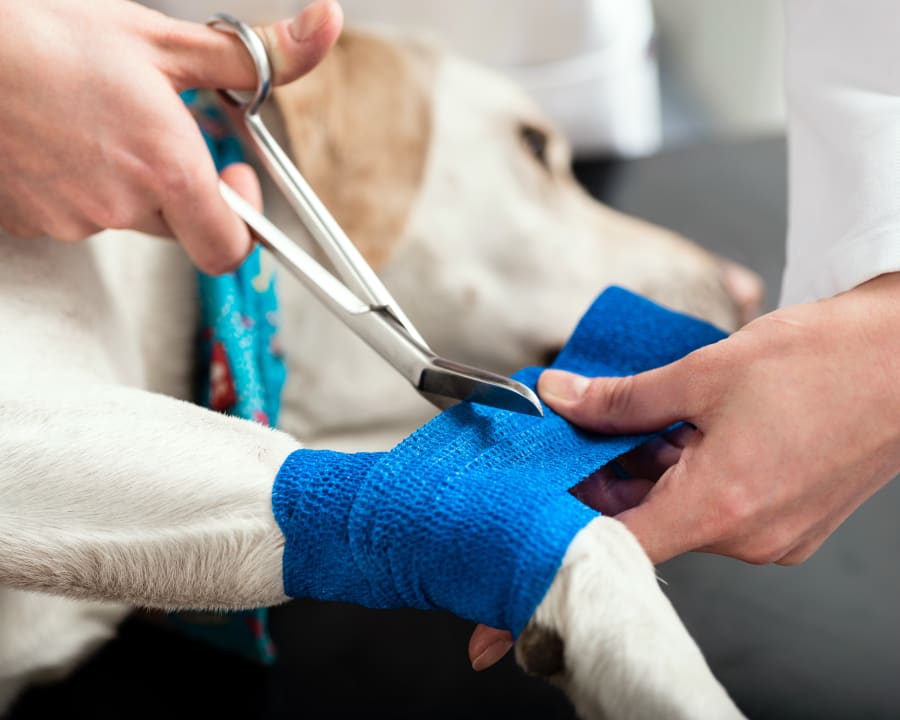Veterinary Pet Rehabilitation in Springfield
Rehabilitative therapy is used to enhance, accelerate and optimize function after surgery or injury. It may also be used conservatively prior to surgery or prophylactically if an animal is at risk for disability. Rehabilitative therapy can have a positive effect on bone healing, recovery or damaged neurologic tissues, muscle, tendon, ligaments and cartilage.
Studies have shown that early and continued mobilization is beneficial to the recovery of tissues. Prolonged periods of rest can have an adverse effect on tissue healing. Treatments may help with strength and range of motion deficits, balance problems, edema and pain control, lameness, poor endurance, gait deviations, decreased activity or function, and weight loss. Specific treatments are determined after an in-depth evaluation is performed.
The evaluation may include, but is not limited to: strength, range of motion, limb circumference, balance, function and gait. Any precautions are obtained through discussions with the supervising veterinary specialist and/or referring veterinarian.

Our Rehabilitative Therapy Providers
Veterinary rehabilitative therapy requires extensive knowledge about animal physiology natural healing processes, and health. Meet our rehabilitative therapy providers!
Rehabilitative Treatments at The Regional Veterinary Referral Center
Treatments vary depending on the diagnosis, precautions, objective findings and subjective reports. Some of the most frequently used modalities are ice, heat, ultrasound, electrical stimulation, phototherapy, therapeutic exercise, functional activities, swimming, underwater treadmill, joint mobilization and range of motion exercises.
Home exercise programs are provided to clients to support treatments given in the hospital. This increases client involvement and will improve compliance upon discharge from rehabilitative services.
The Process
Therapeutic exercises improve the movement of synovial fluid, reducing enzymes that break down cartilage, thus promoting healthier joints in cats and dogs.
We use a variety of therapeutic exercises at The Regional Veterinary Referral Center to reintroduce healthy movement including treadmills, balance boards, physioball exercises, circling, cavalettis, surface variation, changing incline/hills, and stair climbing.
Goals are set based on objective and subjective findings as well as client expectations, but ultimately focus on returning the pet to their previous level of function.
Veterinarians should refer their clients to the Rehabilitative Therapy program at The Regional Veterinary Referral Center. All cases will be reviewed by a board-certified surgeon prior to the initiation of therapy.
Who Needs Rehabilitative Therapy?
Many conditions are appropriate referrals for rehabilitative therapy. They include, but are not limited to:
-
Orthopedic Cases
- Cranial cruciate ligament repairs
- Elbow dysplasia (fragmented medial coronoid process/OCD)
- External fixation
- Hip dysplasia
- Leg Calve Perthes
- Limb salvages
- Medial patellar luxations
- Musculoskeletal oncology
- Osteoarthritis
- Osteochondritis dissecans
- Post-op femoral head and neck ostectomy
- Post-op total hip replacement
- Rotational pelvic osteotomy
- Subluxations
- Tibial plateau leveling osteotomy
-
Neurological Cases
- Brachial plexus avulsions
- Degenerative myelopathy
- Disc disease
- Fibrocartilagenous embolism
- Lumbosacral stenosis
-
Health and Wellness
- Endurance Training
- Weight Loss
-
Splinting
- Custom splinting is available for various needs such as carpal hyperextension injuries, nerve deficits or areas in need of immobilization.
